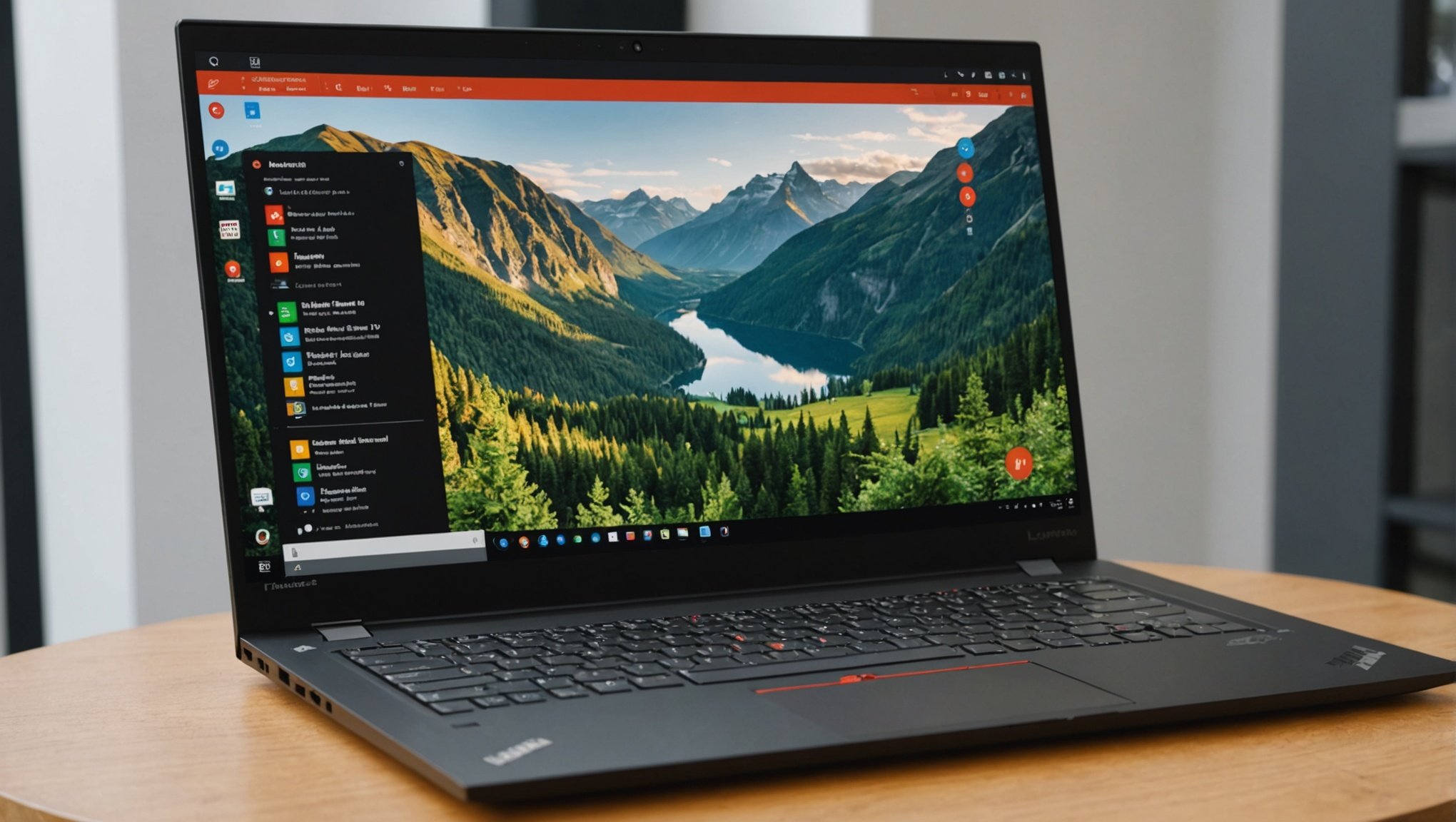The demand for remote work has skyrocketed, and having the right setup can drastically improve productivity and comfort. If you’re using a Lenovo ThinkPad X1 Carbon and want to optimize it for remote work with multiple external monitors, you’re in the right place. This guide will cover everything you need to know, from hardware requirements to software configurations, so you can create an efficient and ergonomic workspace.
Choosing the Right External Monitors
When you decide to add external monitors to your Lenovo ThinkPad X1 Carbon setup, the first step is to choose the correct monitors that meet your needs. Not all monitors are created equal, and different types will serve various purposes better.
This might interest you : What are the best practices for setting up a secure and efficient home automation system using a Google Nest Hub?
Monitor Size and Resolution
Selecting the right monitor size and resolution is crucial for comfort and productivity. Larger monitors with higher resolution can display more content, allowing you to multitask efficiently. A 27-inch monitor with a 1440p resolution is a great balance between size and clarity. For those who need even more screen real estate, a 32-inch monitor with a 4K resolution could be ideal.
Connectivity Options
Ensure your Lenovo ThinkPad X1 Carbon and the external monitors have compatible connectivity options. The X1 Carbon typically comes with Thunderbolt 3, HDMI, and USB-C ports. Monitors with matching ports will simplify the connection process. Thunderbolt 3 is particularly advantageous because it can carry video, data, and power simultaneously, reducing cable clutter.
In the same genre : What are the steps to set up a virtualized environment on a HP ProLiant DL380 Gen10 for running multiple isolated applications?
Additional Features
Consider monitors with ergonomic stands for height adjustment, tilt, and swivel capabilities. These features can help you maintain a comfortable viewing angle and posture, which is essential for long hours of remote work. Integrated USB hubs can also be beneficial, allowing you to connect peripherals easily.
Setting Up Your Workspace
Having the right physical setup is as important as the hardware itself. A well-organized and ergonomic workspace can significantly enhance your productivity and reduce physical strain.
Desk and Chair
Investing in a high-quality desk and chair can make a world of difference. Your desk should have enough space to accommodate multiple monitors, your ThinkPad X1 Carbon, and other accessories like a keyboard and mouse. An adjustable chair with lumbar support is vital for maintaining good posture.
Monitor Placement
Proper monitor placement can reduce eye strain and improve comfort. Place the monitors at eye level and at a distance where you can easily read the text without straining your eyes. The ideal distance is usually around an arm’s length away from your face.
Cable Management
Multiple external monitors can lead to a tangled mess of cables. Efficient cable management can keep your workspace neat and organized. Use cable ties, clips, or a cable management box to keep everything in order. This not only looks better but also reduces the risk of tripping over cables.
Lighting
Good lighting is often overlooked but is crucial for a productive workspace. Natural light is ideal, but if that’s not an option, invest in a high-quality desk lamp. Avoid placing monitors directly in front of or behind bright light sources to reduce glare.
Configuring Your Lenovo ThinkPad X1 Carbon
Once you have the physical setup ready, the next step is to configure your Lenovo ThinkPad X1 Carbon to work seamlessly with the external monitors. This involves both hardware and software adjustments.
Connecting the Monitors
Start by connecting your external monitors to the ThinkPad X1 Carbon. Use the Thunderbolt 3, HDMI, or USB-C ports depending on the connectivity options of your monitors. If you need more ports, a docking station can be a valuable addition. Lenovo offers several docking stations compatible with the X1 Carbon, providing additional ports and simplifying the connection process.
Display Settings
After connecting the monitors, it’s time to configure your display settings. Right-click on the desktop and select “Display settings” to access the display configuration menu. Here, you can:
- Arrange the monitors: Drag and drop the monitor icons to match their physical arrangement on your desk.
- Select the primary monitor: Choose which monitor will be the primary display where the taskbar and icons are located.
- Adjust resolution and scaling: Ensure each monitor is set to its native resolution for the best clarity. You may also adjust the scaling to make text and icons easier to read.
Power Settings
Optimizing power settings can extend the battery life of your ThinkPad X1 Carbon and reduce energy consumption. In the “Power & sleep settings” menu, you can configure:
- Screen timeout: Set a reasonable screen timeout to save power without disrupting your workflow.
- Sleep mode: Configure when the laptop should enter sleep mode when not in use.
- Battery saver: Enable battery saver mode to extend battery life during long work sessions.
Optimizing Software for Remote Work
With the hardware and physical setup in place, optimizing your software environment is the next step. The right software configurations can streamline your workflow and enhance productivity.
Operating System Updates
Keeping your operating system up to date ensures you have the latest features, security patches, and performance improvements. Regularly check for updates in the “Windows Update” menu or use Lenovo Vantage, a tool that helps manage system updates and other settings.
Productivity Software
Select productivity software that suits your work style and needs. Common tools for remote work include:
- Microsoft Office 365: A comprehensive suite for word processing, data analysis, presentations, and email.
- Slack or Microsoft Teams: Essential for communication and collaboration with team members.
- Zoom or Microsoft Teams: For video conferencing and virtual meetings.
- Trello or Asana: Project management tools to keep track of tasks and deadlines.
Virtual Desktop Software
Virtual desktop software can enhance your remote work experience by allowing you to access your workspace from anywhere. Tools like VMware Horizon or Microsoft Remote Desktop provide a seamless remote desktop experience, enabling you to work as if you were in the office.
Backup Solutions
Regular backups are crucial to protect your data. Use cloud storage solutions like OneDrive, Google Drive, or Dropbox for automatic backups. Additionally, consider external hard drives for local backups, providing an extra layer of security for your files.
Ergonomic and Health Considerations
Optimizing your Lenovo ThinkPad X1 Carbon for remote work is not just about technology; it also involves considering your health and well-being. Proper ergonomics can prevent discomfort and long-term health issues.
Posture and Positioning
Maintain a neutral posture by keeping your feet flat on the floor, your knees at a 90-degree angle, and your back straight. Position your monitors at eye level to prevent neck strain and your keyboard and mouse at a comfortable height to avoid wrist strain.
Regular Breaks
Taking regular breaks is essential for maintaining productivity and reducing physical strain. Follow the Pomodoro Technique, which involves working for 25 minutes and then taking a 5-minute break. Use this time to stretch, walk around, or do a quick exercise to refresh your mind and body.
Eye Care
Staring at screens for extended periods can cause eye strain. Follow the 20-20-20 rule: every 20 minutes, look at something 20 feet away for at least 20 seconds. This helps reduce eye strain and keeps your vision healthy.
Standing Desks and Accessories
Consider using a standing desk or a desk converter to alternate between sitting and standing throughout the day. This can improve circulation and reduce the risk of musculoskeletal problems. Additionally, ergonomic accessories like keyboard trays, wrist rests, and footrests can further enhance your comfort.
Optimizing your Lenovo ThinkPad X1 Carbon for remote work with multiple external monitors involves a combination of selecting the right hardware, setting up an ergonomic workspace, configuring your laptop, and optimizing software. By following these guidelines, you can create a comfortable and efficient remote work environment that enhances your productivity and well-being. Remember, the key is to balance technology with ergonomics to achieve the best possible remote work experience.






